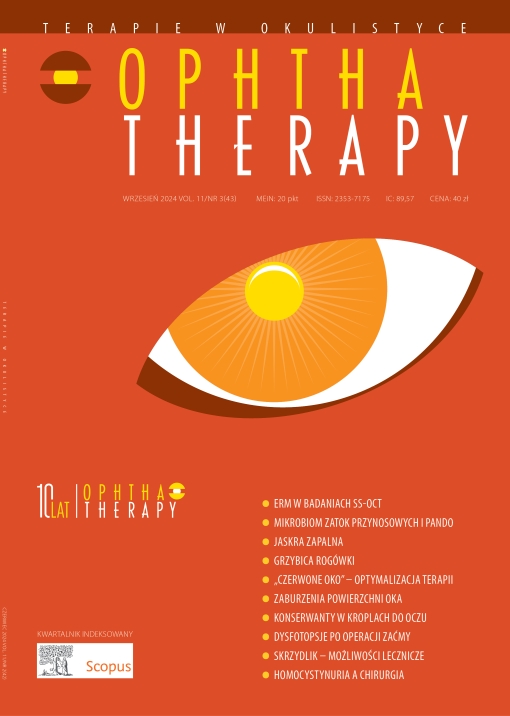Możliwości terapeutyczne w leczeniu jaskry zapalnej Artykuł przeglądowy
##plugins.themes.bootstrap3.article.main##
Abstrakt
W pracy zostały przedstawione możliwości farmakologiczne i metody chirurgiczne leczenia jaskry zapalnej. Głównymi celami farmakoterapii są kontrola stanu zapalnego i zmniejszenie ciśnienia śródgałkowego. Leki przeciwzapalne to przede wszystkim miejscowe glikokortykosteroidy, a także niesteroidowe leki przeciwzapalne oraz terapia immunomodulująca. Nadciśnienie oczne leczone jest β-adrenolitykami, inhibitorami anhydrazy węglanowej, analogami prostaglandyn, agonistami receptora α2-adrenergicznego. Jeżeli farmakoterapia nie przynosi oczekiwanych efektów, to musimy zastosować leczenie chirurgiczne. Ze względu na ryzyko reaktywacji zapalenia zalecenia mówią, że można je przeprowadzić 3 miesiące po wyleczeniu stanu zapalnego. Obecnie złotym standardem pozostaje trabekulektomia. Spośród inwazyjnych technik omawiamy trabekulektomię z zastosowaniem mitomycyny C i mikrohakową, laseroterapię, implanty drenujące jaskrę, głęboką sklerektomię oraz wiskokanalostomię.
Pobrania
##plugins.themes.bootstrap3.article.details##
Copyright: © Medical Education sp. z o.o. License allowing third parties to copy and redistribute the material in any medium or format and to remix, transform, and build upon the material, provided the original work is properly cited and states its license.
Address reprint requests to: Medical Education, Marcin Kuźma (marcin.kuzma@mededu.pl)
Bibliografia
2. Sayed MS, Lee RK. Current management approaches for uveitic glaucoma. Int Ophthalmol Clin. 2015; 55(3): 141-60. http://doi.org/10.1097/IIO.0000000000000071.
3. Łazicka-Gałecka M, Guszkowska M, Gałecki T et al. Epidemiology, pathophysiology and diagnosis of uveitic glaucoma and ocular hypertension secondary to uveitis. Klinika Oczna/Acta Ophthalmologica Polonica. 2023; 125(1): 7-12. http://doi.org/10.5114/ko.2023.126355.
4. Muñoz-Negrete FJ, Moreno-Montañés J, Hernández-Martínez P et al. Current Approach in the Diagnosis and Management of Uveitic Glaucoma. Biomed Res Int. 2015; 2015: 742792. http://doi.org/10.1155/2015/742792.
5. Sherman ER, Cafiero-Chin M. Overcoming diagnostic and treatment challenges in uveitic glaucoma. Clin Exp Optom. 2019; 102(2): 109-15. http://doi.org/10.1111/cxo.12811.
6. Cantrill HL, Palmberg PF, Zink HA et al. Comparison of in vitro potency of corticosteroids with ability to raise intraocular pressure. Am J Ophthalmol. 1975; 79(6): 1012-7. http://doi.org/10.1016/0002-9394(75)90687-x.
7. McGhee CN, Dean S, Danesh-Meyer H. Locally administered ocular corticosteroids: benefits and risks. Drug Saf. 2002; 25(1): 33-55. http://doi.org/10.2165/00002018-200225010-00004.
8. Sung VC, Barton K. Management of inflammatory glaucomas. Curr Opin Ophthalmol. 2004; 15(2): 136-40. http://doi.org/10.1097/00055735-200404000-00014.
9. Phulke S, Kaushik S, Kaur S et al. Steroid-induced Glaucoma: An Avoidable Irreversible Blindness. J Curr Glaucoma Pract. 2017; 11(2): 67-72. http://doi.org/10.5005/jp-journals-l0028-1226.
10. Foster CS, Kothari S, Anesi SD et al. The Ocular Immunology and Uveitis Foundation preferred practice patterns of uveitis management. Surv Ophthalmol. 2016; 61(1): 1-17. http://doi.org/10.1016/j.survophthal.2015.07.001.
11. Shokoohi-Rad S, Daneshvar R, Jafarian-Shahri M et al. Comparison between Betamethasone, Fluorometholone and Loteprednol Etabonate on intraocular pressure in patients after keratorefractive surgery. J Curr Ophthalmol. 2017; 30(2): 130-5. http://doi.org/10.1016/j.joco.2017.11.008.
12. Yoo YJ, Yang HK, Hwang JM. Efficacy and Safety of Loteprednol 0.5% and Fluorometholone 0.1% After Strabismus Surgery in Children. J Ocul Pharmacol Ther. 2018; 34(6): 468-76. http://doi.org/10.1089/jop.2017.0145.
13. Karimian F, Faramarzi A, Fekri S et al. Comparison of Loteprednol with Fluorometholone after Myopic Photorefractive Keratectomy. J Ophthalmic Vis Res. 2017; 12(1): 11-6. http://doi.org/10.4103/2008-322X.200161.
14. Eilon LA, Walker SR. Clinical evaluation of clobetasone butyrate eye drops in the treatment of anterior uveitis and its effects on intraocular pressure. Br J Ophthalmol. 1981; 65(9): 644-7. http://doi.org/10.1136/bjo.65.9.644.
15. Leibowitz HM, Ryan WJ Jr, Kupferman A. Comparative anti-inflammatory efficacy of topical corticosteroids with low glaucoma-inducing potential. Arch Ophthalmol. 1992; 110(1): 118-20. http://doi.org/10.1001/archopht.1992.01080130120038.
16. Al Hanaineh AT, Hassanein DH, Abdelbaky SH et al. Steroid-induced ocular hypertension in the pediatric age group. Eur J Ophthalmol. 2018; 28(4): 372-7. http://doi.org/10.1177/1120672118757434.
17. Leibowitz HM, Bartlett JD, Rich R et al. Intraocular pressure-raising potential of 1.0% rimexolone in patients responding to corticosteroids. Arch Ophthalmol. 1996; 114(8): 933-7. http://doi.org/10.1001/archopht.1996.01100140141005.
18. Arellanes-García L, Padilla-Aguilar G, Navarro-López P et al. Comparación de la eficacia de la prednisolona y la rimexolona en el tratamiento de iridociclitis aguda en pacientes HLA-B27 positivos [Efficacy of prednisolone and rimexolone in HLA-B27 positive patients with acute anterior uveitis]. Gac Med Mex. 2005; 141(5): 363-6.
19. Sendrowski DP, Jaanus SD, Semes LP et al. Anti-Inflammatory Drugs. In: Clinical ocular pharmacology. Fifth edition. Bartlett JD, Jaanus SD (eds.). Butterworth-Heinemann, St. Louis 2008: 223.
20. Sponsel WE, Paris G, Trigo Y et al. Latanoprost and brimonidine: therapeutic and physiologic assessment before and after oral nonsteroidal anti-inflammatory therapy. Am J Ophthalmol. 2002; 133(1): 11-8. http://doi.org/10.1016/s0002-9394(01)01286-7.
21. Heo J, Sepah YJ, Yohannan J et al. The role of biologic agents in the management of non-infectious uveitis. Expert Opin Biol Ther. 2012; 12(8): 995-1008. http://doi.org/10.1517/14712598.2012.688021.
22. Škrlová E, Svozílková P, Heissigerová J et al. Pathogenesis and current methods of treatment of secondary uveitic glaucoma. A review. Cesk Slov Oftalmol. 2023; 79(3): 111-115. http://doi.org/10.31348/2023/7.
23. Tanna AP, Rademaker AW, Stewart WC et al. Meta-analysis of the efficacy and safety of alpha2-adrenergic agonists, beta-adrenergic antagonists, and topical carbonic anhydrase inhibitors with prostaglandin analogs. Arch Ophthalmol. 2010; 128(7): 825-33. http://doi.org/10.1001/archophthalmol.2010.131.
24. Zimmerman TJ. Topical ophthalmic beta blockers: a comparative review. J Ocul Pharmacol. 1993; 9(4): 373-84. http://doi.org/10.1089/jop.1993.9.373.
25. Li F, Huang W, Zhang X. Efficacy and safety of different regimens for primary open-angle glaucoma or ocular hypertension: a systematic review and network meta-analysis. Acta Ophthalmol. 2018; 96(3): e277-e284. http://doi.org/10.1111/aos.13568.
26. Gupta SK, Niranjan DG, Agrawal SS et al. Recent advances in pharmacotherapy of glaucoma. Indian J Pharmacol. 2008; 40(5): 197-208. http://doi.org/10.4103/0253-7613.44151.
27. Strahlman E, Tipping R, Vogel R. A double-masked, randomized 1-year study comparing dorzolamide (Trusopt), timolol, and betaxolol. International Dorzolamide Study Group. Arch Ophthalmol. 1995; 113(8): 1009-16. http://doi.org/10.1001/archopht.1995.01100080061030.
28. Talluto DM, Wyse TB, Krupin T. Topical carbonic anhydrase inhibitors. Curr Opin Ophthalmol. 1997; 8(2): 2-6. http://doi.org/10.1097/00055735-199704000-00002.
29. Hu J, Vu JT, Hong B et al. Uveitis and cystoid macular oedema secondary to topical prostaglandin analogue use in ocular hypertension and open angle glaucoma. Br J Ophthalmol. 2020; 104: 1040-4.
30. Sallam A, Sheth HG, Habot-Wilner Z et al. Outcome of raised intraocular pressure in uveitic eyes with and without a corticosteroid-induced hypertensive response. Am J Ophthalmol. 2009; 148(2): 207-13.e1. http://doi.org/10.1016/j.ajo.2009.02.032.
31. Watson P, Stjernschantz J. A six-month, randomized, double-masked study comparing latanoprost with timolol in open-angle glaucoma and ocular hypertension. The Latanoprost Study Group. Ophthalmology. 1996; 103(1): 126-37. http://doi.org/10.1016/s0161-6420(96)30750-1.
32. Johnstone MA. Hypertrichosis and increased pigmentation of eyelashes and adjacent hair in the region of the ipsilateral eyelids of patients treated with unilateral topical latanoprost. Am J Ophthalmol. 1997; 124(4): 544-7. http://doi.org/10.1016/s0002-9394(14)70870-0.
33. Łazicka-Gałecka M, Guszkowska M, Gałecki T et al. Review of pharmacological and surgical treatment options of uveitic glaucoma. Klinika Oczna/Acta Ophthalmologica Polonica. 2023; 125(2): 65-74. http://doi.org/10.5114/ko.2022.117207.
34. Magliyah MS, Badawi AH, Alshamrani AA et al. The Effect of Perioperative Uveitis Control on the Success of Glaucoma Surgery in Uveitic Glaucoma. Clin Ophthalmol. 2021; 15: 1465-75. http://doi.org/10.2147/OPTH.S301648.
35. Kanaya R, Kijima R, Shinmei Y et al. Surgical Outcomes of Trabeculectomy in Uveitic Glaucoma: A Long-Term, Single-Center, Retrospective Case-Control Study. J Ophthalmol. 2021; 2021: 5550776. http://doi.org/10.1155/2021/5550776.
36. Sotani N, Kusuhara S, Matsumiya W et al. Outcomes of Microhook ab Interno Trabeculotomy in Consecutive 36 Eyes with Uveitic Glaucoma. J Clin Med. 2022; 11(13): 3768. http://doi.org/10.3390/jcm11133768.
37. Yokoyama H, Takata M, Gomi F. One-year outcomes of microhook trabeculotomy versus suture trabeculotomy ab interno. Graefes Arch Clin Exp Ophthalmol. 2022; 260(1): 215-24. http://doi.org/10.1007/s00417-021-05333-7.
38. Mori S, Tanito M, Shoji N et al. Noninferiority of Microhook to Trabectome: Trabectome versus Ab Interno Microhook Trabeculotomy Comparative Study (Tram Trac Study). Ophthalmology Glaucoma. 2022; 5(4): 452-61. http://doi.org/10.1016/j.ogla.2021.11.005.
39. Cakir I, Altan C, Yalcinkaya G et al. Anterior chamber laser flare photometry after diode laser cyclophotocoagulation. Photodiagnosis Photodyn Ther. 2022; 37: 102580. http://doi.org/10.1016/j.pdpdt.2021.102580.
40. Aujla JS, Lee GA, Vincent SJ et al. Incidence of hypotony and sympathetic ophthalmia following trans-scleral cyclophotocoagulation for glaucoma and a report of risk factors. Clin Exp Ophthalmol. 2013; 41(8): 761-72. http://doi.org/10.1111/ceo.12088.
41. Chow A, Burkemper B, Varma R et al. Comparison of surgical outcomes of trabeculectomy, Ahmed shunt, and Baerveldt shunt in uveitic glaucoma. J Ophthalmic Inflamm Infect. 2018; 8(1): 9. http://doi.org/10.1186/s12348-018-0150-y.
42. Mercieca K, Steeples L, Anand N; Medscape. Deep sclerectomy for uveitic glaucoma: long-term outcomes. Eye (Lond). 2017; 31(7): 1008-19. http://doi.org/10.1038/eye.2017.80.
43. El-Saied HMA, Abdelhakim MASE. Different surgical modalities for management of uveitic glaucoma: 2 year comparative study. Acta Ophthalmol. 2022; 100(1): e246-52. http://doi.org/10.1111/aos.14889.

